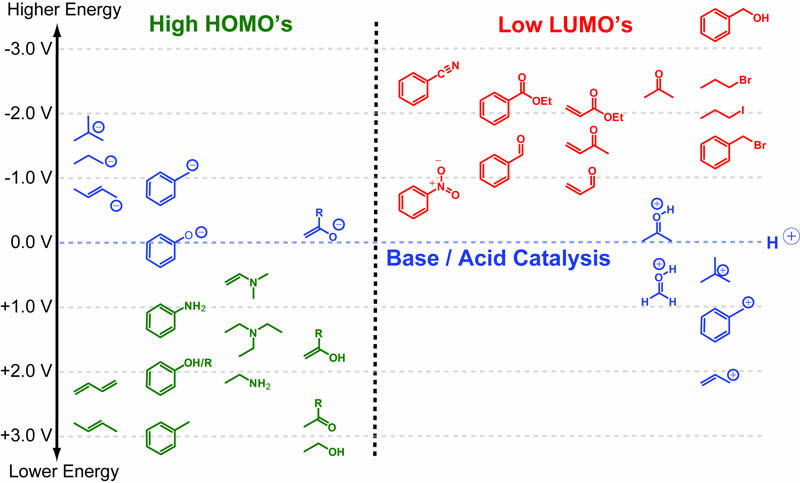

- #Homo lumo organic chemistry how to#
- #Homo lumo organic chemistry software#
- #Homo lumo organic chemistry series#
38 All model systems have fully planar equilibrium geometries which were verified to be true minima by performing analytical vibrational frequency analyses. 37 The effect of solvation in dichloromethane (DCM) was simulated using the conductor‐like screening model (COSMO). Scalar‐relativistic effects were accounted for by using the zeroth‐order regular approximation (ZORA). 33, 34, 35 Electronic ground‐state geometry optimizations have been performed at GGA BP86 36 in combination with the TZ2P Slater‐type basis set, and a small frozen core (FC).
#Homo lumo organic chemistry software#
From the obtained insights, we design a NIR absorbing organic dye as a proof‐of‐concept.Īll calculations have been performed using Amsterdam Density Functional 2016 quantum chemistry package developed by Software for Chemistry & Materials. A fragment‐based analysis is used to evaluate how the tuning parameters of the separate building blocks transpire into the linear D‐π‐A molecule.

The absorption behavior, oscillator strength, and extent of excited state ICT for the linear D‐π‐A frameworks are presented as are the underlying relationships between the electronic and structural changes of the building blocks by using acenes/heteroacenes (i.e., (sila)benzene and (sila)anthracene), their substituents (X: NH 2 and Y: CN), and the D‐π‐A internal rotation as tuning parameters.
#Homo lumo organic chemistry series#
Our computational approach is based on a diverse series of modular models composed from simple donor (D), spacer (π), and acceptor (A) building blocks (Scheme (Scheme1). Here, we present design principles for the rational construction of small dyes with S 0–S 1 absorptions ( E 0(S1)) in the NIR. Ab initio methods can unravel the factors controlling orbital energies, overlaps, HOMO–LUMO gaps, and symmetries and thereby might provide insight into a possible causal relationship between the absorption properties and the dye's tuning parameters.
#Homo lumo organic chemistry how to#
Of course, it is well‐known that both extending the conjugation length 28 and introducing donor/acceptor push‐pull effects 29, 30, 31, 32 cause a redshift of the absorption maxima, but how to tune them in tandem is still missing. 25, 26, 27 So far, there is no comprehensive rationale to predict the behavior of the dyes based on the constituents from which they are built. 23, 24 There are very few closed‐shell neutral organic molecules that absorb effectively in the NIR range and simultaneously exhibit charge‐transfer excitation. 15, 16, 17, 18, 19 However, advancing such organic dyes is hampered by complex molecular arrangements 20, 21, 22 and a large π‐scaffold with poor excited state intramolecular charge transfer (ICT) nature. 7, 8, 9 Their tunability, 10, 11, 12, 13 synthetical accessibility, and low toxicity 14 give them an advantage over alternate inorganic materials. These are also commonly referred to as HOMO-1 and LUMO+1, respectively.Near‐infrared (NIR) absorbing organic dyes (650–950 nm) are highly sought after for application as an emitter in tissue imaging 1, 2 and organic electronics, 3, 4, 5, 6 and as a photosensitizer in organic photovoltaics. They are named NHOMO for next-to-highest occupied molecular orbital and SLUMO for second lowest unoccupied molecular orbital. If existent, the molecular orbitals at one energy level below the HOMO and one energy level above the LUMO are also found to play a role in frontier molecular orbital theory. This abbreviation may also be extended to semi occupied molecular orbital. In organometallic chemistry, the size of the LUMO lobe can help predict where addition to pi ligands will occur.Ī SOMO is a singly occupied molecular orbital such as half-filled HOMO of a radical. The same analogy can be made between the LUMO level and the conduction band minimum. The HOMO level is to organic semiconductors roughly what the maximum valence band is to inorganic semiconductors and quantum dots. The difference in energy between these two frontier orbitals can be used to predict the strength and stability of transition metal complexes, as well as the colors they produce in solution. HOMO and LUMO are sometimes collectively called the frontier orbitals, such as in the frontier molecular orbital theory. The energy difference between the HOMO and LUMO is termed the HOMO–LUMO gap. The acronyms stand for highest occupied molecular orbital and lowest unoccupied molecular orbital, respectively. In chemistry, HOMO and LUMO are types of molecular orbitals.


 0 kommentar(er)
0 kommentar(er)
